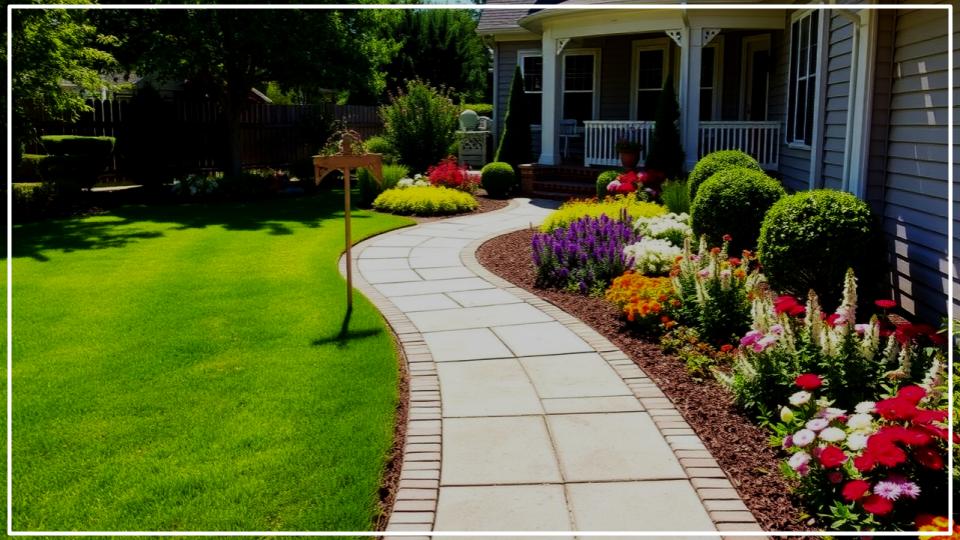
A truly captivating front yard does more than just frame your home; it extends a warm, gracious welcome to all who arrive. It’s the first impression, a daily delight, and a source of quiet pride. Many of us admire landscapes with that certain je ne sais quoi—a polished, high-end feel—and assume it requires a team of designers and a breathtaking budget. But I’m here to let you in on a professional secret: an expensive look is often the result of smart design, not lavish spending. These brilliant front yard landscaping ideas focus on timeless principles of structure, scale, and health to deliver that luxurious aesthetic without the shocking price tag. Let’s explore how you can cultivate undeniable curb appeal.
Quick Tips for Instant Elegance
Here’s the key to achieving a high-end look on a budget:
- Create Crisp Edges: The sharpest, cleanest line you can create between your lawn and garden beds is the fastest way to look polished.
- Go Big on Planters: One or two large, dramatic containers make a bigger impact than a clutter of small pots.
- Mulch in Dark Tones: A consistent layer of dark-colored mulch makes plants pop and instantly unifies the landscape.
- Plant in Groups of 3, 5, or 7: Planting in odd-numbered drifts creates a lush, natural look that feels professionally designed.
Master the Art of the Crisp Edge
The single most effective way to achieve a look of refined care is to create a deep, clean edge between your lawn and planting beds. A wobbly, indistinct line where grass creeps into the mulch looks untidy, while a sharp, defined border communicates intention and meticulous upkeep. In my own garden, I find that redefining my edges each spring is the most transformative task I undertake.
You don’t need expensive metal or stone edging. A simple spade-cut edge, often called a “Victorian trench,” is classic, elegant, and completely free. Simply use a flat-bladed spade or a half-moon edger to cut a clean line, then come back with a trowel to trench a small, 4-to-6-inch-deep channel at a 45-degree angle, removing the excess soil. According to the University of New Hampshire Extension, this simple physical barrier is highly effective at preventing turfgrass from invading your beds. It’s a bit of work, but the payoff in visual clarity is immense.
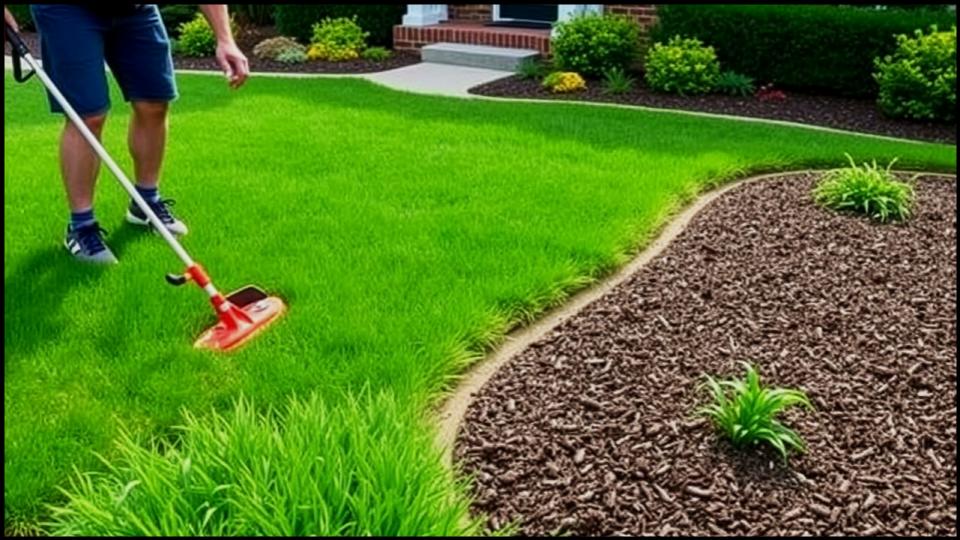
Go Big with Containers
When it comes to container gardening for curb appeal on a budget, scale is your secret weapon. A scattered collection of small, mismatched pots can look cluttered and accidental. Instead, invest in the largest one or two containers you can afford to flank your doorway or mark an entrance to a walkway.
Large planters have a significant presence and serve as powerful focal points. They anchor your entryway and allow for dramatic, multi-layered plantings—what we call the “thriller, filler, spiller” method. You don’t need to buy heavy, expensive ceramic pots either. Modern fiberglass or resin containers offer the same grand scale and sophisticated profiles for a fraction of the cost and weight.
Plant in Lush Drifts, Not Lonely Dots
One of the most common mistakes I see in DIY front yards is what I call “plant polka dots”—single specimens of different plants dotted throughout a bed. A high-end design nearly always features plants grouped in masses, or “drifts.” Planting a single variety in odd-numbered groups of three, five, or seven creates a wave of color and texture that is far more impactful and natural-looking.
This approach to affordable landscaping is also budget-savvy. Buying multiples of the same hardworking perennial is often more cost-effective than buying a dozen different “one-of-everything” plants. This technique of massing plants provides a cohesive and intentional look, making the overall design feel more harmonious and professionally planned, a principle echoed by landscape design experts at the University of Minnesota Extension.
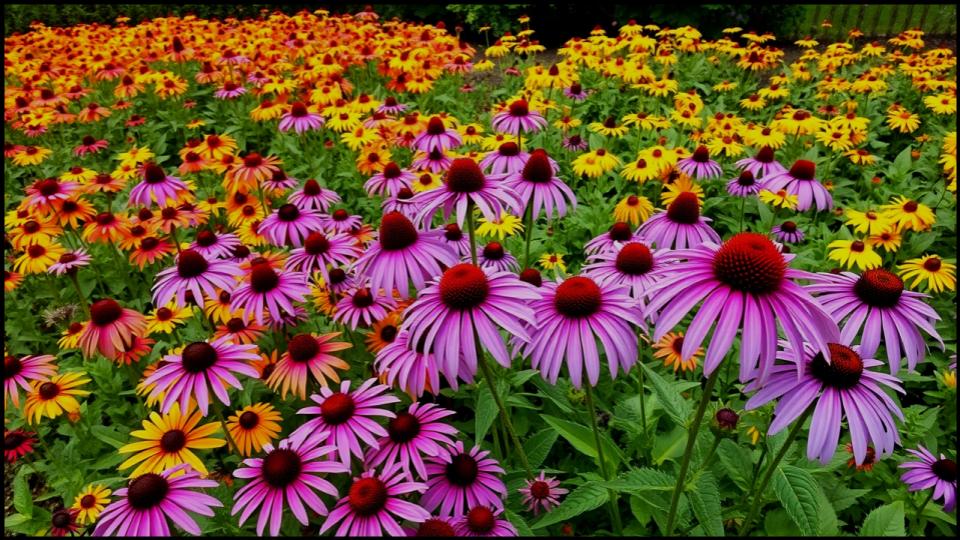
Embrace Strategic Repetition
Repetition is a foundational principle of design that creates rhythm and unity. In the garden, this means repeating a key plant, color, or form in several places throughout the yard. This doesn’t mean your entire yard should be identical, but it should feel connected.
For instance, if you have a beautiful blue-gray hosta in a container by the door, repeat that same hosta variety along the front of a shady border. If you use black-eyed Susans (Rudbeckia hirta) in a sunny spot, echo that golden-yellow color with a different plant, like a daylily, farther down the path. This simple act of repetition guides the eye through the landscape and makes the entire design feel cohesive and thoughtfully composed—a hallmark of professional work.
Create a Grand Entrance with an Arbor
Nothing says “welcome to my garden” quite like an arbor. It adds vertical interest, creates a sense of passage, and provides a perfect support for beautiful climbing plants. While custom-built hardwood arbors are costly, many DIY front yard ideas for arbors are surprisingly affordable.
Simple wooden or metal arch arbors are available at most garden centers for a modest price. Painted a sophisticated dark charcoal, black, or even a classic white, they can look far more expensive than they are. Train a climbing rose, a fragrant jasmine, or an elegant clematis up the sides. My go-to for a fast-growing, beautiful display is the ‘Sweet Autumn’ clematis (Clematis terniflora), which covers an arbor in a cloud of fragrant white blossoms in late summer.
Elevate Your Mulch Game
Mulch is not just functional; it’s a critical design element. The right mulch unifies planting beds, suppresses weeds, retains moisture, and provides a perfect, dark canvas that makes your plants’ foliage and flowers pop.
Forgo the brightly dyed red or gold wood chips, which can look artificial and cheapen the aesthetic. Opt instead for finely shredded, dark brown or black mulch. A natural material like dark hardwood or pine bark fines provides a rich, earthy appearance that signals a well-tended and sophisticated garden. Applying a consistent 2-to-3-inch layer across all your beds creates a clean, cohesive look that instantly elevates the entire front yard.
Illuminate with Inexpensive Solar Lighting
Landscape lighting adds a touch of magic and luxury to a garden after dusk, but custom hard-wired systems are a major expense. Thankfully, modern solar lighting has come a long way in both quality and style.
The key is to use it strategically. Instead of a “runway” look with lights spaced evenly along a path, use just a few to uplight a specimen tree, a stone wall, or the dramatic foliage of a large hosta. This technique, known as accent lighting, creates depth and highlights the most beautiful features of your yard. Look for solar spotlights with a warm white light temperature (around 2700K-3000K) for a soft, high-end glow rather than a harsh blue-white light.
Choose Perennials Over Annuals
While annuals provide a fantastic burst of instant, season-long color, a garden that relies heavily on them can feel a bit temporary and requires a complete replanting (and reinvestment) each year. Perennials, which return year after year, form the backbone of a sophisticated garden design.
Investing in a framework of robust perennials like hostas, daylilies, peonies, ornamental grasses, and coneflowers builds a garden with structure, texture, and multi-season interest. As they mature and fill in over the years, they give the garden a permanent, established feel that is the essence of a luxe landscape. You can still tuck in a few annuals for pops of color, but the perennials will do the heavy lifting.
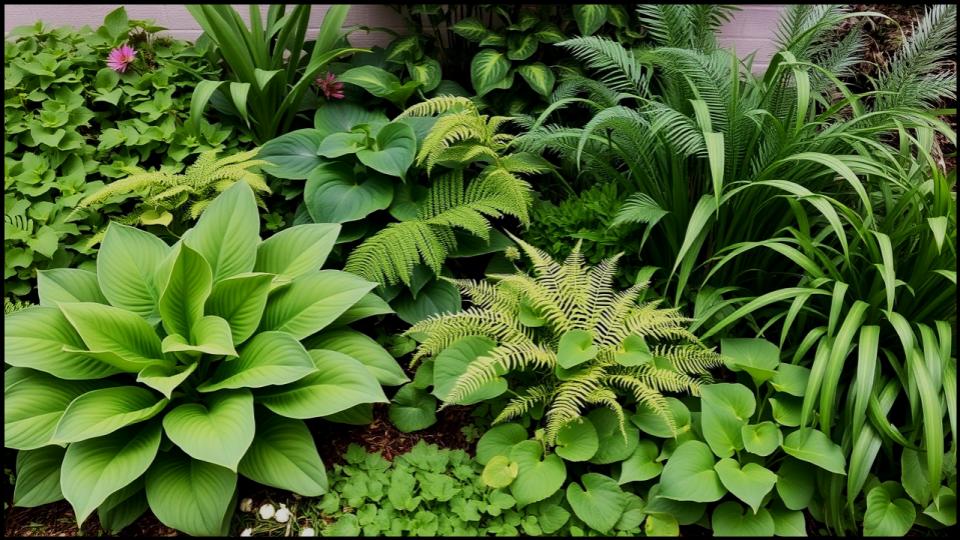
Add a Statement Rock or Two
Well-placed boulders or large rocks add a sense of age, permanence, and natural drama to a landscape. A single, characterful boulder can serve as a powerful focal point, an organic alternative to a statue or birdbath.
You don’t need to arrange a whole quarry. Often, just one or three strategically placed rocks (remember the rule of odds!) of a decent size can anchor a corner bed or add interest to a flat area. Check with local landscape suppliers or even construction sites (with permission, of course) for affordable options. When placing them, bury the bottom third of the rock in the soil. This is a pro trick that makes it look as though it has been there forever, a part of the natural landscape.
Hide Eyesores with Clever Screening
Every home has them: utility boxes, trash cans, or air conditioning units. Leaving these exposed immediately detracts from the beauty of your front yard. An elegant solution is to obscure them with attractive screening.
A simple panel of wooden lattice, painted to match your home’s trim, is an inexpensive and effective solution. Plant a well-behaved, non-aggressive vine to grow up it for a living green screen. Another one of my favorite DIY front yard ideas is creating a small “fence” with three fence posts and two horizontal boards, creating a clean, modern screen that can be built in an afternoon.
Invest in a Flawless Lawn (or Lawn Alternative)
Your lawn is the canvas for your entire front yard picture. A patchy, weed-filled lawn will undermine even the most beautiful plantings. You don’t need a golf course, but a uniformly green and healthy lawn creates a lush, plush carpet that looks incredibly high-end.
Focus on the basics of good lawn care: proper mowing (mowing high encourages deep roots), adequate watering, and seasonal feeding. For those seeking a lower-maintenance or more eco-friendly option, a lawn alternative like a creeping thyme or clover lawn can create a similarly lush, green expanse with less work and water, as noted by sustainability-focused institutions like the Missouri Botanical Garden.
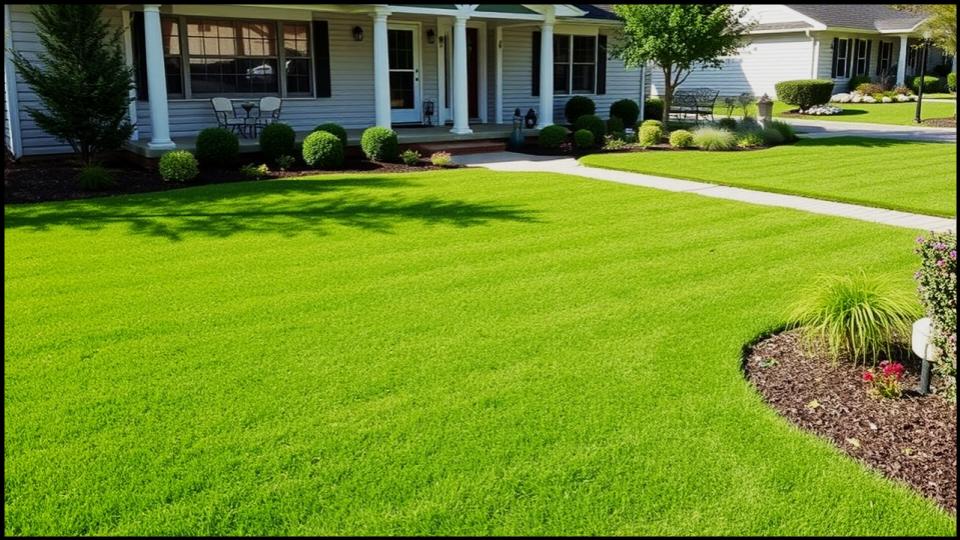
A Garden That Gives Back
Creating a front yard that looks luxurious is not about extravagant spending; it’s about thoughtful choices and a little bit of horticultural know-how. By focusing on strong lines, strategic planning, and meticulous care, you can cultivate a sophisticated landscape that will be a source of joy for years to come. These front yard landscaping ideas prove that the most valuable gardens are not the ones that cost the most, but the ones that are most lovingly tended. Now you’re ready to roll up your sleeves and create a truly stunning welcome to your home.
Read More
7 Plants You Must Prune in April for Explosive Spring and Summer Blooms
